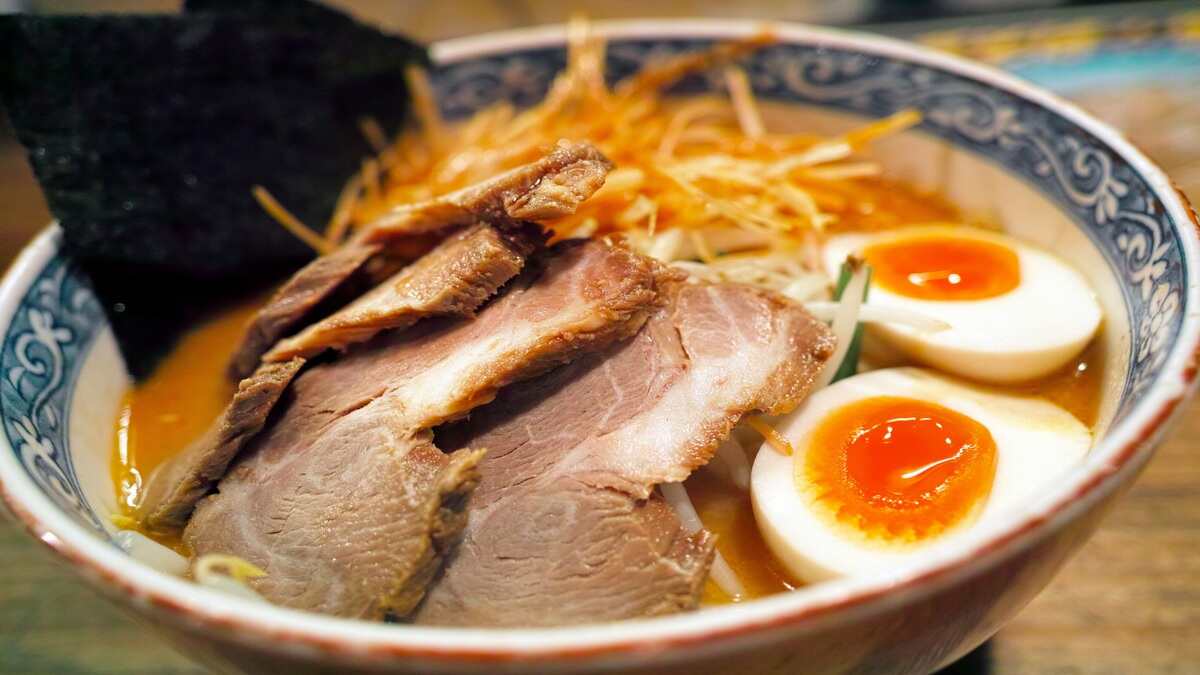Ramen is the ultimate comfort food, combining savory broth, chewy noodles, and a medley of toppings that make every bowl uniquely satisfying. One of the most iconic toppings for a bowl of ramen is the soft-boiled egg, known for its rich, creamy yolk that enhances the flavor of the broth. This blog will guide you through creating your own Ramen with Soft-Boiled Egg Recipe an easy yet indulgent dish you can enjoy at home.
What Is Ramen with Soft-Boiled Egg Recipe?
Ramen is a Japanese noodle soup dish that has become a global favorite, known for its layers of flavor and comforting qualities. Adding a soft-boiled egg, also known as Ajitsuke Tamago, elevates the dish with its rich texture and umami flavor. The egg is often marinated in soy sauce and mirin, giving it a savory, slightly sweet taste that complements the broth and noodles.
The Origin of Ramen with Soft-Boiled Egg Recipe
Ramen originated in China but was adapted by Japanese cuisine in the late 19th century. Over time, it evolved into a culinary art, with regional variations featuring different broths, toppings, and noodles. Today, ramen is enjoyed worldwide, ranging from instant noodles to gourmet bowls served in upscale restaurants.
Ingredients for Ramen with Soft-Boiled Egg Recipe
| Ingredient | Quantity |
| Eggs | 2 large |
| Soy sauce | ¼ cup |
| Mirin (sweet rice wine) | 2 tbsp |
| Water (for marinating) | 2 tbsp |
| Instant or fresh ramen noodles | 2 packs |
| Chicken or vegetable broth | 4 cups |
| Garlic (minced) | 2 cloves |
| Ginger (grated) | 1 tsp |
| Soy sauce (for broth) | 2 tbsp |
| Sesame oil | 1 tsp |
| Green onions (sliced) | 2 stalks |
| Nori (seaweed) sheets | 2 small pieces |
| Bean sprouts (optional) | ½ cup |
| Chili oil or flakes (optional) | 1 tsp |

Equipment Needed
- Medium saucepan
- Slotted spoon
- Mixing bowl
- Whisk or fork
- Measuring cups and spoons
- Ramen bowls or large soup bowls
Step-by-Step Preparation
1. Making the Soft-Boiled Egg
- Boil the Eggs: Bring a medium saucepan of water to a boil. Lower the eggs into the water using a slotted spoon. Reduce the heat to a gentle simmer and cook for exactly 6 minutes for a soft, runny yolk.
- Cool the Eggs: Transfer the eggs to an ice bath to stop the cooking process. Let them cool for 5 minutes, then carefully peel the shells.
- Marinate the Eggs: In a bowl, whisk together soy sauce, mirin, and water. Submerge the peeled eggs in the marinade and refrigerate for at least 1 hour (or overnight for a stronger flavor).
2. Preparing the Broth
- Sauté Aromatics: In a medium saucepan, heat sesame oil over medium heat. Add the minced garlic and grated ginger, stirring until fragrant, about 1-2 minutes.
- Simmer the Broth: Pour in the chicken or vegetable broth and bring to a gentle simmer. Stir in soy sauce and adjust the seasoning to taste. Let it simmer for 10-15 minutes to develop the flavors.
3. Cooking the Noodles and Assembling the Ramen
- Cook the Noodles: Prepare the ramen noodles according to the package instructions. Drain and set aside.
- Assemble the Bowl: Divide the cooked noodles between two bowls. Ladle the hot broth over the noodles.
- Add Toppings: Slice the marinated soft-boiled eggs in half and place them on top of the noodles. Add green onions, nori, bean sprouts, and any other desired toppings. Drizzle with chili oil or sprinkle with chili flakes for extra spice.
Health Benefits ofRamen with Soft-Boiled Egg Recipe
- High in Protein: The soft-boiled egg provides high-quality protein, essential for muscle repair and growth.
- Rich in Nutrients: Broth-based ramen offers vitamins and minerals from the garlic, ginger, and green onions, which also boost immunity and digestion.
- Customizable Nutrition: Use whole-grain noodles or low-sodium broth to make the dish healthier.
- Heart-Healthy Fats: Sesame oil and egg yolks contain healthy fats that support brain function and heart health.
- Low in Calories (with Adjustments): Homemade ramen can be lighter than instant varieties, especially if you control the portion of noodles and use fresh ingredients.
Unique Tips for Perfect Ramen with Soft-Boiled Egg Recipe
- Use Fresh Noodles: For the best texture, opt for fresh ramen noodles if available.
- Marinate Longer: For deeper flavor, marinate the eggs overnight in the soy-mirin mixture.
- Broth Enhancers: Add miso paste, dashi stock, or a splash of sake for an authentic Japanese flavor.
- Add Texture: Include crunchy toppings like fried garlic, crispy onions, or toasted sesame seeds.
- Make It Vegetarian: Use vegetable broth and tofu as a protein alternative for a vegetarian version.
Best Ways to Serve Ramen with Soft-Boiled Egg Recipe
- As a Meal: Serve it as a standalone dish, as it’s hearty enough to satisfy on its own.
- With Sides: Pair with Japanese sides like gyoza (dumplings) or a light cucumber salad.
- For Brunch: Serve as a unique brunch option, featuring the soft-boiled egg as a highlight.
- Family Style: Prepare the noodles and toppings separately so everyone can customize their own bowl.
- Add Spiciness: Provide chili paste or spicy miso for guests who love heat.
Calories and Nutritional Information
| Nutrient | Amount Per Serving (1 Bowl) |
| Calories | ~450 |
| Protein | ~20g |
| Fat | ~15g |
| Carbohydrates | ~50g |
| Fiber | ~4g |
| Sodium | ~800mg |

Prep Time and Cook Time
| Task | Time Required |
| Prep Time | 10 minutes |
| Cook Time | 20 minutes |
| Marinate Time | 1 hour (optional) |
| Total Time | ~1 hour 30 minutes |
Conclusion
Ramen with Soft-Boiled Egg Recipe is a comforting and flavorful dish that combines the richness of marinated eggs, the heartiness of noodles, and the warmth of savory broth. With a little preparation, this recipe allows you to bring the authentic flavors of Japanese ramen into your own kitchen. Whether you’re craving something cozy on a chilly day or looking to impress guests with a restaurant-quality meal, this ramen recipe is sure to deliver.
FAQs
1. Can I make the eggs ahead of time?
Yes, marinated eggs can be stored in the refrigerator for up to 3 days. The longer they marinate, the more flavorful they become.
2. What’s the best way to reheat ramen?
Reheat the broth separately from the noodles to prevent them from becoming soggy. Combine them just before serving.
3. Can I use instant ramen noodles?
Absolutely! Instant ramen noodles work well if you’re short on time. Just discard the seasoning packet and use your homemade broth.
4. Can I add meat to the ramen?
Yes, sliced chicken, pork belly, or even shrimp can be added for extra protein and flavor.
5. Is this recipe gluten-free?
To make it gluten-free, use gluten-free noodles and tamari instead of soy sauce.
